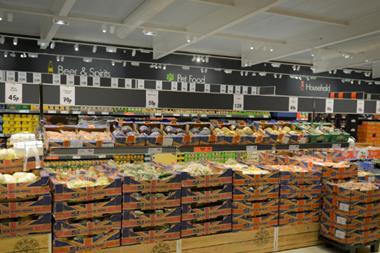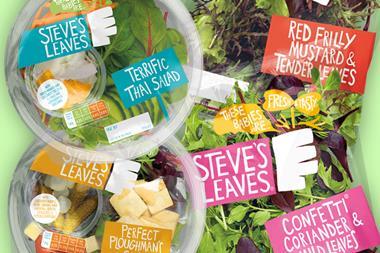The supermarkets can no longer hide from the facts: despite their best efforts, Brits are eating just three of the recommended 5 a day and consumption of fruit & veg is in decline, an NFU report out last week has found, with UK sales of fruit 14% lower and vegetables 5% in 2014 than 2007.
Underlining the importance of fruit & veg to tackling the obesity crisis and a host of diet-related diseases, the NFU argues UK retailers have a “responsibility” to do more to boost sales. Indeed, these findings come just four years after supermarkets signed a Responsibility Deal pledge promising to “do more to create a positive environment that supports and enables people to increase their consumption of fruit & veg”.
So where has the UK gone wrong on fruit & veg? Are supermarkets to blame? And what more can they do to live up to their Deal pledge?
Based on research by Royal Agricultural University, as well as industry and government consultations, the NFU’s Fit for the Future report doesn’t just single out supermarkets. It warns the whole UK fruit & veg supply chain has failed to keep pace with changes in eating habits - such as the shift away from three meals a day to a ‘ food grazing’ lifestyle.
A lack of ‘convenient’ options means ‘food swamps’ have developed, it argues, with healthy options being crowded out as snack and fast foods extend their dominance.
“People are snacking and buying on the hoof but the industry is still not thinking like that,” says NFU lead on the report and horticulture chair Ali Capper. “We need to be challenging our sector to think about produce in the same way as convenience foods, and put fruit & veg in front of people more often.”
With this in mind, the report sets out 34 ‘options for action’ for retailers, foodservice, processors and producers, which draw on a wide range of global studies and initiatives from around the world.
Recommendations for retailers include “multi-siting” fruit & veg alongside ready meals and at the checkouts, in stores, including them in lunchtime meal deals, as well as selling more “snack-ready” products (see box).
Capper believes the NFU will be “knocking on an open door” when it comes to encouraging retailers to adopt the recommendations. With fruit and veg consumption in decline, they have clearly not achieved their promises under the Responsibility Deal yet, but it is not for want of trying. “Some of the things we are asking them to do are quite difficult and will have a commercial impact, but this report provides the evidence of why that investment is worth it.”
While “very supportive” of the NFU’s objectives, however, the BRC refutes suggestions retailers haven’t lived up to their Responsibility Deal pledge.
“The key from our perspective is increasing consumer demand and retailers have done much already in this regard such as price-promoting fruit & veg in supermarkets, offering pre-prepared fruit & veg and promoting ‘ugly’ produce, says BRC senior external affairs adviser Fintan Hastings.
Doing enough?
NFU’s key ideas
Retailers
- Increase fruit & veg content in ready meals by one portion per meal
- Place fruit & veg in multiple areas of store
- Improve positioning on shelf
- Develop fruit & veg snacks
- Introduce ‘chilled’ checkouts
- Put storage instructions on outer packaging
- Use tools such as floor markers and trolley or basket placards
- Improve the use of shelf labels that identify healthy products
- Increase staff knowledge about healthy food choices and nutrition
- Promote product tastings and recipe cards
- Integrate fruit & veg into meal deals
Food service
- Put fruit & veg at the beginning of buffets, rather than the end
- Increase the range of food products that include fruit and veg
- Label food products in vending machines, buffets and on menus
- Develop “fun shaped” fruit & veg products for kids
Farming and processing
- Develop new crop varieties and new forms of packaging
- Develop cross sector marketing and promotion campaigns
- Reformulate existing products
- Embed storage instructions onto pre-packed fruit and veg
- Create new convenient fruit & veg products
- Increase the proportion of fruit & veg snacks
- Implement growing techniques that improve the nutritional quality of fruit & veg
- Build engagement with food bloggers and other influential commentators
Government
- Put fruit and veg consumption at the heart of the forthcoming Childhood Obesity Strategy
- Develop a cohesive strategy for enabling fruit and veg consumption
- Provide more information on the nutritional benefits of potatoes
- Revisit planning regulations
- Redesign the layout of food service areas in schools, hospitals and government workplaces
- Promote increased visibility of fruit and veg within the School Food Plan
- Undertake a feasibility study
- Extend the Healthy Start programme
- Provide additional advice on juice and juicing of fruit and veg
- Provide an enabling environment for food reformulation
The mults can point to a number of initiatives to boost fruit & veg sales over the past few years. Not least the discounters.
Aldi has added 80 new fresh produce lines in just three years, says Jonathan Neale, joint MD of corporate buying. The discounter also promotes fresh fruit & veg daily through its Super 6 offer, and has signed the NFU’s fruit & veg pledge to work with British growers.
Lidl has also put a big focus on fruit & veg, says head of fresh produce buying Jon Covey, and sells over 20% more fresh produce year on year. “Our approach has been supported by our market-leading Pick of the Week price promotions, making fruit & veg more easily accessible for all our customers, encouraging them to try a range of new and exciting fresh produce every week,” he adds.
And where the discounters have led, the big four have followed, especially on price. Morrisons stocks a “wide range” of fruit and veg in stores, with 40% on seasonal and promotional offer to encourage customer consumption and support British farmers. “The result is that we overtrade on key seasonal British lines, such as Jersey Royals and strawberries,” says a spokesman.
Co-op Food has a range of initiatives from price promotions to developing new healthy snacks, says a spokesman. “We are the only retailer that publicly sets a target to ensure a minimum of 30% of our promotions are on healthier products, and our fruit & veg offer has led to a 15% increase in sales.”
Suppliers have also made a concerted effort to boost consumption, claims the FDF. “Many leading manufacturers are adding more fruit or veg to their ranges and clearly labelling products that contribute one of your 5 a day,” says a spokeswoman.
However, efforts have been hindered by the current debate around sugar, she argues. “Adding extra tomato to sauces or dried fruit to cereal, which could help increase intakes, can be seen negatively due to the increase in total sugars.”
With both manufacturers and retailers making big strides on affordability, the focus, the BRC’s Hastings argues, “needs to be on better cooking skills and education, supported by consistent messaging that busts the myth about eating healthier being the more expensive option.”
The NFU does recognise the need for better education. The report’s recommendations to government include putting fruit & veg at the heart of the Childhood Obesity Strategy and extending the Healthy Start programme.
But Capper insists the supply chain - including retailers - must also ramp up efforts to divert the looming public health crisis. “Obesity is costing us £5.1bn a year,” she says. “There is now a moral imperative to act.”



















1 Readers' comment